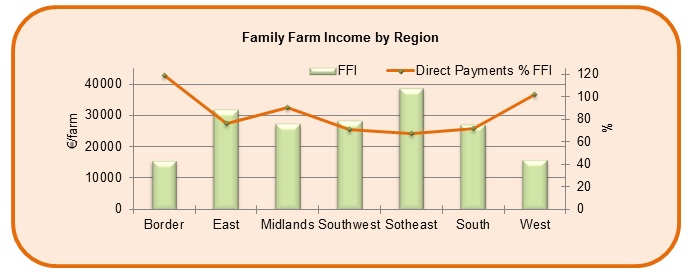As was to be expected today’s preliminary estimates from the Teagasc National Farm Survey 2013 results show contrasting fortunes across the different components of Irish farming, with dairy farm incomes increasing but average incomes for all the other enterprises decreasing.
Teagasc themselves admit that although the average income level on Irish farms increased slightly in 2013 (up 1%) to €25,639, the stability in the average level, masks the dramatically increasing gap between dairy incomes and those in other enterprises.
Commenting on the results Teagasc Director, Professor Gerry Boyle also highlighted that the contrasting outcomes of dairy and non-dairy farmers are also reflected in the average farm outcomes across Ireland’s regions in 2013. He said: “Those regions where dairy farming is more concentrated (the Southwest, South East and South) saw average incomes increase, while incomes in other regions, which have a greater dependence on drystock and tillage farming, saw declines. The largest increase in average family farm incomes occurred in the South Region (Cork and Kerry) where average farm incomes increased by 24%, while incomes in the Midlands region, where drystock farming and tillage dominates, declined by 16 %.”
Looking back on 2013 Teagasc noted that poor weather in the first quarter and the continuing impact of the 2012 fodder crisis led to dramatic increases in feed and fertiliser expenses for all grassland based farming systems. Farmers’ expenditure on purchased concentrate and bulky feed increased dramatically, while in the second half of 2013 expenditure on fertiliser increased as farmers worked to rebuild depleted stocks of conserved forage. On average direct costs of production increased by 11% when compared with 2012.
Cattle Rearing family farm incomes declined by 22% due to higher costs of production. Cattle Other and Sheep farm incomes declined by 13% and 39% respectively in 2013 due to lower levels of output combined with higher costs of production. On Tillage farms, despite largely stable costs of production and higher yields, lower prices and lower areas harvested led to lower output and lower family farm incomes. On dairy farms despite large increases in costs of production (+11%) average incomes increased strongly due to both higher prices (+23%) and increased levels of milk output per hectare (+11%).
In 2013 the average Irish farm received 8% less in direct payments as compared to 2012 due to reductions in single payment receipts, agri-environmental payments (REPS) and the ending of the suckler cow welfare scheme. Dr Kevin Hanrahan, Teagasc Agricultural Economics and Farm Surveys department said; ”On average the dependence of family farm income on subsidies declined in 2013 as compared to 2012. However, on
Cattle Rearing, Cattle Other and Sheep farms direct payments still accounted for significantly more than family farm incomes. This overwhelming dependence of incomes on direct payments highlights the fact that on many Irish farms costs of production far exceeded returns from the market in 2013.”
Incomes on farms with a dairy enterprise increased in 2013 and almost fully reversed the large drop in incomes experienced in 2012. In 2013 the average dairy farm income was €64,371. The increase in dairy farm incomes was driven by the large increase in the milk prices received by farmers along with additional production per hectare. Like other grassland systems, direct costs of production on dairy farms (mostly feed and fertiliser) increased in 2013. However, unlike cattle and sheep farmers, the increases in output prices received by dairy farmers were sufficient to deliver strong income growth.
However Anne Kinsella of the Teagasc Agricultural Economics and Farm Surveys Department did deliver a word of warning for the buoyant sector when she said; “While welcome, this improvement highlights the vulnerability of dairy incomes to increasingly volatile milk prices.”


